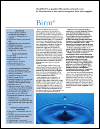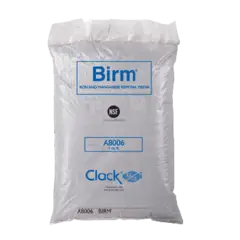Light-Weight Media for the Removal of Iron
Birm® is an economical and light weight media used primarily for the removal of dissolved iron. Under certain conditions, it can also be used to reduce manganese. Birm® media acts as a catalyst to enhance the oxidation of dissolve iron and manganese to create precipitates which are then mechanical filtered in the media bed. Birm® is not consumed in the oxidation process and it does not need to be chemically regenerated.
Birm® is a coated media, meaning that the active ingredient is contained only within the relatively thin outer layer of each granule. This makes it more vulnerable to mechanical wear and tear and chemical degradation than many other iron removal media. Accordingly, exposure to strong oxidizers like chlorine will damage Birm®. However, the inner core is relatively light making Birm® easier to backwash (backwash at lower flow rates with less water volume overall).
- Economical - lower cost compared to alterantive iron removal options
- Low weight (< 40 lbs / ft3) - lower backwash flow rate
- Chemical regeneration not required
Birm® is very popular due to its relatively low price and light weight. However, it is not recommedned for all iron treatment applications. Operating conditions should fall within the manufacturer's guidelines to ensure optimal performance. As noted, Birm® can be successfully used to remove manganese as well as iron under certain conditions, however, other media options such as Filox™ and Katalox Light® should be considered where manganese is being targeted, and especially if hydrogen sulfide (rotten egg smell) is also present. If used for manganese removal, the pH of the feed water should be in the range of 8.0 to 8.5 if iron is also being treated, or in the range of 8.0 to 9.0 if manganese is targetted alone. Caution should be applied where iron is present and the pH exceeds 8.5 as colloidal iron can form and can be very difficult to remove.
Other important considerations when using Birm® media:
- Suggested service flow rates are typically lower than other iron removal media - locally favorable operating conditions may allow higher flow rates
- pH must be at least 6.8 (7.0 or greater strongly recommended)
- We do not recommended Birm® where total organic carbon (TOC) exceeds 4 ppm, or if oil, or hydrogen sulfide (rotten egg odor) are present
- If the dissolved oxygen content of the feed water is not at least 15% of the iron level (and 29% of manganese content), pre-aeration is required (to enhance performance, we recommend pre-aeration with most Birm® filters)
- Free chlorine will damage Birm® - levels should not exceed 0.5 ppm (mg/l)
- Alkalinity should be 2 times the combined sulfate and chloride levels
- Pre-treat with polyphosphates will cause treatment failure
- NOT FOR INSTALLATION IN CALIFORNIA
Operating Conditions / Requirements:
| Service Flow Rate: | 3.5 to 5 GPM per ft2 |
|---|---|
| Flow Direction: | Downward Flow |
| Typical Pressure Drop: | 2-4 psi |
| Backwash Flow Rate: | 10-12 GPM per ft2 |
| Typical Freeboard: | 50% |
| Backwash Bed Expansion: | 20-40% |
| Minimum Bed Depth: | 30-36 Inches |
| Recommended Bed Depth: | 30-36 Inches |
| Maximum Feed Temperature: | 100F |
| Recommended pH: | 6.8 to 9.0 |
| Weight: | 35-40 lbs per ft3 |
| Service Flow Rate: | 3.5 to 5 GPM per ft2 |
|---|---|
| Flow Direction: | Downward Flow |
| Typical Pressure Drop: | 2-4 psi |
| Backwash Flow Rate: | 10-12 GPM per ft2 |
| Typical Freeboard: | 50% |
| Backwash Bed Expansion: | 20-40% |
| Minimum Bed Depth: | 30-36 Inches |
| Recommended Bed Depth: | 30-36 Inches |
| Maximum Feed Temperature: | 100F |
| Recommended pH: | 6.8 to 9.0 |
| Weight: | 35-40 lbs per ft3 |
Birm® is a federally registered trademark of Clack Corporation.
Downloads

